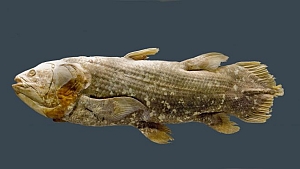
Scientists at A*STAR's Institute of Molecular and Cell Biology (IMCB) and across the world join hands to crack the genomic code of African coelacanth
Singapore: An enigmatic prehistoric fish has brought scientists at A*STAR's Institute of Molecular and Cell Biology (IMCB) together with researchers from all over the world to crack its genomic code. Findings from the study are providing new insights into the evolutionary history of the African coelacanth and possible clues as to how aquatic creatures transitioned to life on land.
Coelacanths resemble the fossilised skeletons of their ancestors from more than 300-million years ago. By sequencing its genome and comparing it to genes of other vertebrate species, the researchers have uncovered valuable information on genetic changes that may have helped aquatic animals to transition from water to land, and adapt to life on land. Their findings include many genes and regulatory elements that were gained and genes that were lost when vertebrates came on land. The research findings were published in the 18 April online issue of the prestigious journal, Nature.
The most interesting feature of the coelacanth is its fleshy fins, which resemble the limbs of land animals. The team has found several important regions of the genome used in the formation of limbs, which suggest that land animals (tetrapods) adopted these sequences from coelacanths to help them form limbs. The researchers also found that there are many regulatory changes that influence genes involved in the perception of smell, as creatures that transitioned to land needed new means of detecting chemicals in their environment.
While sequencing the genome of the coelacanth provides some answers, more information on how some vertebrates adapted to land while others remained in the water can be discerned from future research of coelacanth's physiological systems such as the immune system, respiratory system, and reproductive system.
Prof. Byrappa Venkatesh, Research Director IMCB, whose group was involved in the project said, "The coelacanth with its distinctive fleshy fins represents an intermediary phase in the evolution of land animals from aquatic fishes. By comparing the genomes of coelacanth, human and other vertebrates our group has been able to discover gene regulatory elements that played a key role in the development of our limbs and fingers as well as our ability to detect air-borne odorants. Mutations in these elements can potentially lead to genetic diseases."




